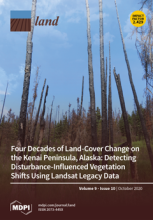/ library resources
Showing items 19 through 27 of 4088.Mountainous regions are more sensitive to climatic condition changes and are susceptible to recent increases in temperature. Due to urbanization and land use/land cover (LULC) issues, Cameron Highlands has been impacted by rising land surface temperature (LST) variation.
Climate-wise connectivity is essential to provide species access to suitable habitats in the future, yet we lack a consistent means of quantifying climate adaptation benefits of habitat linkages.
There are numerous studies on the effect of grazing on the physical and chemical parameters of soils. However, the impact of grazing on the temperature regime of the alas soils in Central Yakutia is still poorly understood.
Well-managed and connected protected area networks are needed to combat the 6th mass extinction, yet the implementation of plans intended to secure landscape connectivity remains insufficient.
The purpose of this research is to better conserve biodiversity by improving land allocation modeling software. Here we introduce a planning support framework designed to be understood by and useful to land managers, stakeholders, and other decision-makers.
Identifying and quantifying conservation-practice adoption in U.S. cropland is key to accurately monitoring trends in soil health regionally and nationally and informing climate change mitigation efforts.
ABSTRACTED FROM EXECUTIVE SUMMARY: On December 30, 2018, Bangladesh held national elections. The election was not deemed fair by observers, and from the point of filing nomination papers to election campaigning, the opposition faced severe political obstacles.
The primary goal of the "Voluntary Guidelines for the Responsible Governance of Tenure of Land, Fisheries and Forests within the Scope of National Food Security" is to achieve food security for all and to support the progressive realization of the right to adequate food within the sco
Bangladesh is the most densely populated country in the world. Its 144,000 square kilometres are home to an estimated 150 million people. About 45 percent (2004) of them live below the national poverty line and around 36 percent are living on US$ 1 per day.
Paginação
Land Library Search
Through our robust search engine, you can search for any item of the over 73,000 highly curated resources in the Land Library.
If you would like to find an overview of what is possible, feel free to peruse the Search Guide.





